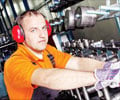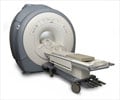The experience of an MRI (magnetic resonance image) exam, which many people describe as stressful and uncomfortable because of the loud noises, could soon become a bit more pleasant,
University of Florida engineering students have developed a new headset that could help make a MRI less-stressful experience. Many patients dread MRI because of the loud noises spewed out by the machine.
The engineering students have designed a headset that shows promise of reducing the extremely loud, repetitive, industrial-like noises that accompany magnetic resonance image examinations.The noises, which range from beeping to whirring to grinding and can often be as loud as a jet engine, stem from the workings of the powerful magnets at the heart of the machines' ability to produce sharply defined internal images of the body or body parts.
The headset would not only make the experience less off-putting, it might also reduce the number of needed exams, freeing up the machine for access by more patients, said Stephen Forguson, a senior majoring in electrical engineering.
"The sound often makes patients move or wriggle a bit. Unfortunately, that can blur the image, which means the operators have to redo the exam," he said.
Forguson and Chad Dailey, Paul Norris and Christopher Ruesga, all also engineering seniors, designed the headset as part of the College of Engineering's Integrated Product and Process Design Program.
The program pairs student teams with corporate or government sponsors for yearlong design projects of products or processes intended to be useful to the sponsor.
Advertisement
But the problem is that no electronics are permitted within the MRI chamber because the electronics can distort or disrupt the images scanned by the machines' magnets. So the difficulty for the UF students was figuring out how to reduce noise without the use of any wires, switches or other electronics with the patient in the chamber.
Advertisement
So the team attempted to solve the problem using existing "air phones," or headphones attached to small tubes, connected via the tubes to specially crafted electronics and software located outside the MRI machine.
The air phones, which are similar to the headphones once distributed on commercial airplanes, pipe the sound via two tubes to tiny microphones connected to an amplifier and a signal processor several feet away. That processor taps an algorithm, or set of computer instructions, to produce a sound signal that is the opposite of the signal just received. That opposite signal then gets piped back through a third tube to each of the patient's ears.
Because the MRI sounds are repetitive and the piped-in sounds are timed to occur on top of the repetitions, the result is that the patient hears the same sound, as he or she would have without any intervention - but at a lower volume.
Trials of the system using a loud beeping sound similar to some MRI noises showed it could reduce the noise by as much as 15 decibels. Ambient noise is about 60 decibels, with jet engines and other extremely loud noises reaching 120 decibels. The students were only able to reduce actual MRI sounds by a smaller level, but they said further.
Source-ANI
RAS/L








